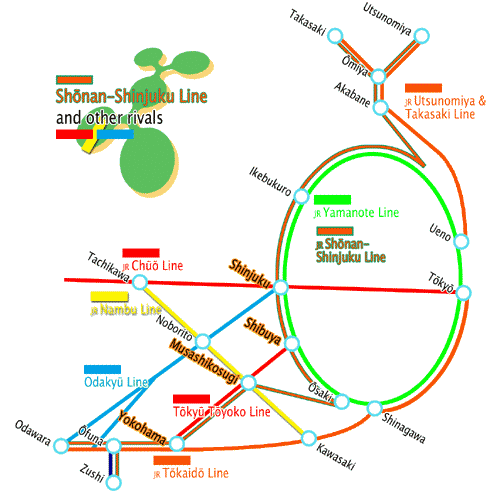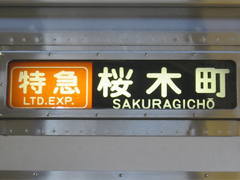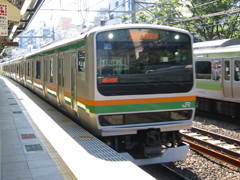The win-at-all-costs struggle between Shinjuku and Yokohama
 Other than the Tōkyū Tōyoko line, there are other ways that lead us from Yokohama to downtown Tōkyō, especially Shinjuku. The Tōyoko line will start a through service with Tokyo Metro 13th line in 2012
and run from Yokohama to Shinjuku and Ikebukuro. On the other hand, JR East started the Shōnan-Shinjuku line on Dec. 1st, 2001.
It runs from Odawara and Zushi to Takasaki and Utsunomiya, via Yokohama, Shinjuku, Ikebukuro, and Ōmiya; it covers many areas of western greater Tōkyō.
Before the Shōnan-Shinjuku line appeared, travel from Yokohama to Shinjuku and Ōmiya was inconvenient. People had had to take two or three trains and taken long time. In fact, it became convenient if traveling from Yokohama to Shinjuku and Ōmiya.
Given a trip from Yokohama to Ōmiya before then, you would first take the Tōkaidō line to Tōkyō, change to the Yamanote line and go to Ueno, and change to the Utsunomiya or Takasaki line to Ōmiya.
It would take over one hour, but the Shōnan-Shinjuku line can do it in less than one hour, and moreover, it needs no transfer.
Other than the Tōkyū Tōyoko line, there are other ways that lead us from Yokohama to downtown Tōkyō, especially Shinjuku. The Tōyoko line will start a through service with Tokyo Metro 13th line in 2012
and run from Yokohama to Shinjuku and Ikebukuro. On the other hand, JR East started the Shōnan-Shinjuku line on Dec. 1st, 2001.
It runs from Odawara and Zushi to Takasaki and Utsunomiya, via Yokohama, Shinjuku, Ikebukuro, and Ōmiya; it covers many areas of western greater Tōkyō.
Before the Shōnan-Shinjuku line appeared, travel from Yokohama to Shinjuku and Ōmiya was inconvenient. People had had to take two or three trains and taken long time. In fact, it became convenient if traveling from Yokohama to Shinjuku and Ōmiya.
Given a trip from Yokohama to Ōmiya before then, you would first take the Tōkaidō line to Tōkyō, change to the Yamanote line and go to Ueno, and change to the Utsunomiya or Takasaki line to Ōmiya.
It would take over one hour, but the Shōnan-Shinjuku line can do it in less than one hour, and moreover, it needs no transfer.
Comparison of the change of the time to go from Yokohama to Shibuya
| Train (Tōyoko line) |
Time (min.) |
Reduction of time |
| Express |
32'30" |
- |
| Tōyoko "limited express" |
28 |
4'30" |
| (Its latest diagram-revised train) |
27 |
5'30" |
| Train (JR lines) |
Time (min.) |
Reduction of time |
| Conventional route*1 |
35 |
- |
| Shōnan-Shinjuku line |
24 |
11 |
| (Its latest diagram-revised train) |
22 |
13 |
*1: Before the Shōnan-Shinjuku line was launched, passengers had to take the JR Tōkaidō line from Yokohama to Shinagawa, and change to the Yamanote line to Shibuya.
These trains are famous for their murderous crowds in mornings; there are about twice the complement of passengers.
The Tōkyū Tōyoko line's "limited express" service (the fastest service) is an influence on the Shōnan-Shinjuku line.
Until the Shōnan-Shinjuku line started, Tōkyū Corporation had run a local train and an express on the Tōyoko line. The express train took 32'30" (the fastest train) to get to Shibuya from Yokohama.
However, the Shōnan-Shinjuku line would take only 24 minutes. In those days the Tōyoko line was good between Yokohama and Shibuya because it was superior to JR in the time and fare.
The Shōnan-Shinjuku line appearing as the rival, Tōkyū launched the limited express service in March 28th, 2001, before the Shōnan-Shinjuku Line.
Before now, both lines became more faster. The Tōyoko limited express takes 27 minutes, whereas the Shōnan-Shinjuku line takes 22 minutes.

Tōyoko limited express
The Tōyoko limited express is the fastest service train in the Tōkyū Tōyoko line.
Though the service is called "limited," passengers don't need any extra payment for these trains. Its name "limited express" may come from the conventional [Japanese-]English translation of the train.
JR challenges Tōkyū to the struggle
JR and Kawasaki City announced (2005) the construction of a new station, to be opened in 2009, between Shin-Kawasaki and Nishi-Ōi on the Yokosuka line, which is also on the Shōnan-Shinjuku line.
And the new station can be called the Musashikosugi station because it will be 300 meters from Musashikosugi station on the Tōyoko line.
Musashikosugi station is also the transfer station of the Tōyoko line and the JR Nambu line. People who live along the Nambu line usually use the Tōyoko line or the Odakyū line to go to Shinjuku
because there are not any trains which directly run to Shinjuku on the Nambu line.
How the Nambu line users get to Shinjuku before and after the new Musashikosugi launches

| Departing station |
Without the new Musashikosugi sta. |
With new M.Kosugi sta. |
| Time |
Fare |
Transfer(s) |
Time |
Fare |
| Kawasaki |
35 |
380 |
Shinagawa, Ōsaki |
38 |
(380) |
| Shitte |
41 |
380 |
Kawasaki, Shinagawa, Ōsaki |
36 |
(380) |
| Yakō |
36 |
510 |
Kashimada, Shin-Kawasaki |
34 |
(380) |
| 43 |
380 |
Kawasaki, Shinagawa, Ōsaki |
| 47 |
350 |
Musashikosugi, Shibuya |
| Kashimada |
31 |
380 |
Shin-Kawasaki on foot |
31 |
380 |
| Hirama |
35 |
510 |
Kashimada, Shin-Kawasaki |
29 |
380 |
| 43 |
340 |
Musashikosugi, Shibuya |
| Mukaigawara |
41 |
340 |
Musashikosugi, Shibuya |
27 |
380 |
| Musashikosugi |
31 |
340 |
Shibuya |
20 |
380 |
| Musashi-Nakahara |
38 |
340 |
Musashikosugi, Shibuya |
28 |
380 |
| 39 |
400 |
Noborito, Yoyogi-Uehara |
| Musashi-Shinjō |
40 |
350 |
Musashikosugi, Shibuya |
31 |
380 |
| 37 |
400 |
Noborito, Yoyogi-Uehara |
| Musashi-Mizonokuchi |
32*2 |
360*2 |
Mizonokuchi on foot, Shibuya |
|
|
| 43 |
350 |
Musashikosugi, Shibuya |
34 |
450 |
| 34 |
390 |
Noborito, Yoyogi-Uehara |
|
|
| Tsudayama |
45 |
350 |
Musashikosugi, Shibuya |
36 |
450 |
| 32 |
390 |
Noborito, Yoyogi-Uehara |
|
|
| Kuzi |
30 |
370 |
Noborito, Yoyogi-Uehara |
38 |
450 |
| Shukugawara |
28 |
370 |
Noborito, Yoyogi-Uehara |
40 |
450 |
| Noborito |
20 |
240 |
Yoyogi-Uehara |
43 |
540 |
| Nakanoshima |
29 |
370 |
Noborito, Yoyogi-Uehara |
|
|
| Inadazutsumi |
31 |
390 |
Noborito |
|
|
| 44 |
240 |
Keiō-Inadazutsumi on foot |
| Yanokuchi |
33 |
390 |
Noborito |
|
|
| Inaginaganuma |
36 |
400 |
Noborito |
|
|
| Minami-Tama |
41 |
400 |
Noborito |
|
|
| Fuchū-Hommachi |
44 |
450 |
Noborito |
|
|
| 43 |
450 |
Nishi-Kokubunji |
| 46 |
400 |
Bubaigawara |
| Bubaigawara |
39 |
270 |
(Keiō line) |
|
|
| Yaho |
47 |
400 |
Bubaigawara |
|
|
| Yagawa |
49 |
420 |
Bubaigawara |
|
|
| 49 |
450 |
Tachikawa |
| Nishi-Kunitachi |
51 |
420 |
Bubaigawara |
|
|
| 47 |
450 |
Tachikawa |
| Tachikawa |
42 |
450 |
(JR Chūō line rapid) |
|
|
Note:
Consider that passengers have to get to Shinjuku station by 8:30 a.m. The Time and Fare of the left part are those which the traveling via the following transfer station(s) takes.
Those also indicate the railway company which passengers mainly use: JR East, Tōkyū, Odakyū, and Keiō Railway.
The right part, the purple-colored Time and Fare are those via the new Musashikosugi station.
In this case, consider that passengers take the Shōnan-Shinjuku line to Shinjuku. If the supposed result on the right is superior to the present result on the left and
it is possible that passengers use the new Musashikosugi station and take the Shōnan-Shinjuku line, the cells are painted green.
(380) means that the trip through the Shōnan-Shinjuku line actually costs ¥450 calculated by its distance, but according to the fare calculation rule,
the fare is calculated with the shortest distance between the departed station and the destination whichever JR line passengers take. In this case, the route via new Musashikosugi is longer than that via Kawasaki,
and the fare is calculated with the distance via Kawasaki despite the fact that passengers don't travel there.
*2: by the Tōkyū Den-en-toshi line.

The left part of the list shows the time and the fare to arrive at Shinjuku by 8:30 a.m. on weekdays from each station of the Nambu line.
There are surely some stations from which the passengers can arrive at Shinjuku faster or cheaper without taking the Tōyoko line to Shibuya.
However, the right part of the list shows the times and fares after the new Musashikosugi station is launched and passengers use the Shōnan-Shinjuku line.
For this comparison, I supposed that the new Musashikosugi will be 20.5 kilometers from Shinjuku and run in 20 minutes, and passengers will need five minutes to change the Nambu line for the Shōnan-Shinjuku line.
Surprisingly, we can find the possibility that all passengers who use the Tōyoko line will take the Shōnan-Shinjuku line to Shinjuku. The new Musashikosugi station will be opened in 2009,
and it will be inevitable that Tōkyu will see a decrease in its passengers and profit. Tōkyū seems to cooperate with Tokyo Metro in the through service, which will begin in 2012, to compete with JR.
Work cited:
East Japan Railway Company (2005) "Press Release (April 4th, 2005)"
[TOP]
[Intro] [Boarding] [Smoking] [Priority] [Phones]
[Vacant] [Comfort] [13th] [Shinjuku] [Hommoku]
Soliloquy of my Railway © Satoshi Oshio, 2005


 Other than the Tōkyū Tōyoko line, there are other ways that lead us from Yokohama to downtown Tōkyō, especially Shinjuku. The Tōyoko line will start a through service with Tokyo Metro 13th line in 2012
and run from Yokohama to Shinjuku and Ikebukuro. On the other hand, JR East started the Shōnan-Shinjuku line on Dec. 1st, 2001.
It runs from Odawara and Zushi to Takasaki and Utsunomiya, via Yokohama, Shinjuku, Ikebukuro, and Ōmiya; it covers many areas of western greater Tōkyō.
Before the Shōnan-Shinjuku line appeared, travel from Yokohama to Shinjuku and Ōmiya was inconvenient. People had had to take two or three trains and taken long time. In fact, it became convenient if traveling from Yokohama to Shinjuku and Ōmiya.
Given a trip from Yokohama to Ōmiya before then, you would first take the Tōkaidō line to Tōkyō, change to the Yamanote line and go to Ueno, and change to the Utsunomiya or Takasaki line to Ōmiya.
It would take over one hour, but the Shōnan-Shinjuku line can do it in less than one hour, and moreover, it needs no transfer.
Other than the Tōkyū Tōyoko line, there are other ways that lead us from Yokohama to downtown Tōkyō, especially Shinjuku. The Tōyoko line will start a through service with Tokyo Metro 13th line in 2012
and run from Yokohama to Shinjuku and Ikebukuro. On the other hand, JR East started the Shōnan-Shinjuku line on Dec. 1st, 2001.
It runs from Odawara and Zushi to Takasaki and Utsunomiya, via Yokohama, Shinjuku, Ikebukuro, and Ōmiya; it covers many areas of western greater Tōkyō.
Before the Shōnan-Shinjuku line appeared, travel from Yokohama to Shinjuku and Ōmiya was inconvenient. People had had to take two or three trains and taken long time. In fact, it became convenient if traveling from Yokohama to Shinjuku and Ōmiya.
Given a trip from Yokohama to Ōmiya before then, you would first take the Tōkaidō line to Tōkyō, change to the Yamanote line and go to Ueno, and change to the Utsunomiya or Takasaki line to Ōmiya.
It would take over one hour, but the Shōnan-Shinjuku line can do it in less than one hour, and moreover, it needs no transfer.


